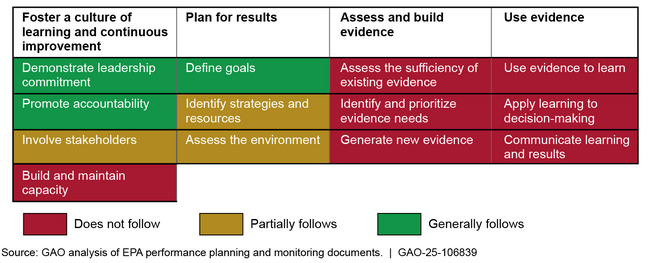New Chemicals Program: EPA Needs a Systematic Process to Better Manage and Assess Performance
Fast Facts
An Environmental Protection Agency program assesses the safety of new chemicals. Chemical manufacturers praised some aspects of the program but shared concerns about unclear requirements, review delays, and more.
EPA may face challenges implementing the program because it doesn't follow some key management practices.
For example, effectively involving stakeholders—such as chemical manufacturers—could help clarify program requirements. Similarly, identifying resource needs could help EPA set and meet program goals like improving review timeliness.
Our recommendations help EPA follow these and other key practices.

Highlights
What GAO Found
Representatives from 19 manufacturers GAO interviewed identified a range of challenges, strengths, and potential improvements for the U.S. Environmental Protection Agency's (EPA) new chemicals review process. For example, most (16 of 19) representatives told GAO they experienced review delays and described effects of these delays on their businesses. Effects manufacturers cited included harming customer relations, creating a competitive advantage for existing chemical alternatives at the expense of new chemicals, and hindering market participation.
Representatives also identified strengths in how EPA implements the program and potential process improvements. For example, almost all (18 of 19) representatives found EPA's public information sources somewhat or very helpful. Representatives suggested that EPA improve the new chemicals review process by clarifying review requirements, providing realistic time frames for completing reviews, and improving communication, among other improvements.
EPA's New Chemicals Division (NCD) has taken some important initial planning steps, but NCD does not follow most key practices for managing and assessing the results of its New Chemicals Program.
Extent to Which the U.S. Environmental Protection Agency (EPA) Follows Key Management and Assessment Practices for Its New Chemicals Program

For example, in August 2024, NCD drafted a strategic plan that identifies five strategic goals and how to achieve them. However, NCD did not follow some relevant key practices in developing the plan, including involving external stakeholders and identifying resources needed to achieve each draft goal. Moreover, NCD officials told GAO that they had not developed a systematic process to ensure that it consistently follows all key practices. Addressing relevant key practices—including involving stakeholders and identifying resources—as NCD finalizes its strategic plan could position the division to better manage and assess the program. Further, implementing a systematic performance process could better position NCD to ensure that it achieves program goals, such as improving the timeliness of reviews.
Why GAO Did This Study
The Toxic Substances Control Act (TSCA), as amended, directs EPA to make a formal determination on the risk of injury to health or the environment on each new chemical before it can be manufactured. However, GAO reported in February 2023 (GAO-23-105728) that EPA typically made its determination within the 90-day TSCA review period less than 10 percent of the time.
GAO was asked to review EPA's implementation of its TSCA New Chemicals Program. This report (1) summarizes the perspectives of selected manufacturers on EPA's review process and (2) evaluates the extent to which EPA follows key practices for managing and assessing the program. GAO identified a random, nongeneralizable sample of notices submitted to EPA from October 2021 to April 2024 and interviewed 19 manufacturers that submitted these notices. GAO also compared EPA's management and assessment activities to key practices it developed based on federal laws, federal guidance, and prior GAO work.
Recommendations
GAO is making two recommendations, including that EPA's NCD address, as it finalizes its strategic plan, relevant key management and assessment practices; and implement a systematic performance management process that aligns with the key practices. EPA agreed with both recommendations.
Recommendations for Executive Action
| Agency Affected | Recommendation | Status |
|---|---|---|
| Environmental Protection Agency | The Administrator of EPA should ensure that NCD, as it finalizes its strategic plan, addresses relevant key practices for managing and assessing the New Chemicals Program, including involving stakeholders and identifying resources. (Recommendation 1) |
When we confirm what actions the agency has taken in response to this recommendation, we will provide updated information.
|
| Environmental Protection Agency | The Administrator of EPA should ensure NCD implements a systematic process that aligns the division's performance management approach with key management and assessment practices. (Recommendation 2) |
When we confirm what actions the agency has taken in response to this recommendation, we will provide updated information.
|
